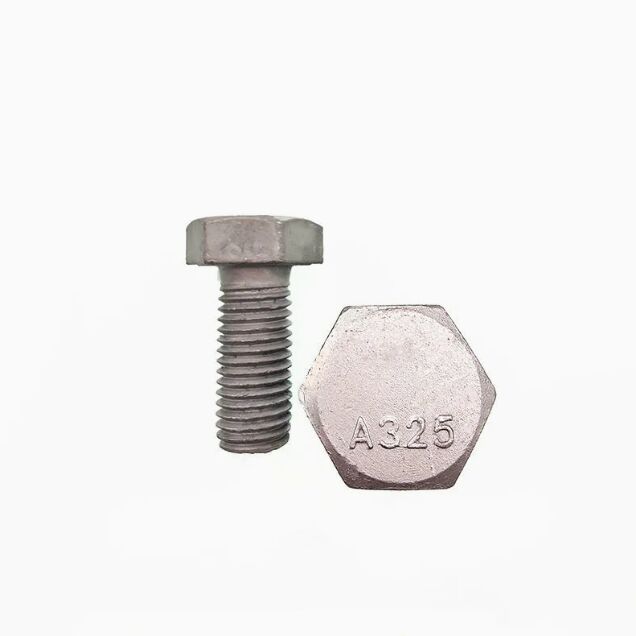A szerepkör megértése A325 Bűvölcsökhármasok a építészi szerkezetekben
Miért kritikusak az A325 csavarak a terhelésviselő szerkezetek szempontjából
Az A325 csavaroknak kritikus szerepe van a szerkezeti mérnöki feladatokban, mivel az erős terhelési viszonyok elviselésére készülnek, biztosítva, hogy az épületek és más szerkezetek biztonságosan viseljék a nagy terheléseket. A mérnökök gyakran ezeket a csavarokat írják elő nagy építési projektekhez, mint például hidak és felhőkarcolók, ahol minden a megbízható, nem megszakadó kapcsolatokon múlik. Az Amerikai Acélépítési Intézet (American Institute of Steel Construction) útmutatása szerint az A325 csavarokkal kapcsolatban szigorúan be kell tartani a megfelelő műszaki előírásokat, mivel ezek minősége közvetlenül befolyásolja az egész szerkezet hosszú távú biztonságát és szilárdságát. Ezeknek a szabványoknak a betartása nem csupán szabályozási előírás, hanem valós különbséget jelent azzal kapcsolatban, hogy az épület különböző alkatrészei mennyire megbízhatóan kapcsolódnak egymáshoz az évek során.
Fontos tulajdonságok: húzóerő és tartóság
Az A325-ös csavarok kimagasló szilárdságukról és hosszú élettartamukról ismertek, ezért gyakran választják őket komoly szerkezeti munkákhoz. A csavarok többsége legalább 120 ksi (ezer font per négyzethüvelyk) szakítószilárdsággal rendelkezik, így képesek nagyon nagy terheléseket elviselni meghibásodás nélkül. A szerkezetek élettartama szempontjából a tartósság rendkívül fontos, és az A325-ös csavarok úgy vannak kialakítva, hogy ellenálljanak a kemény külső körülményeknek évek során. A rozsda- és kopásállóság növelésére a gyártás során különféle bevonatok és felületkezelések alkalmazhatók. Ezek a kiegészítő megoldások hosszabb élettartamot biztosítanak, miközben a fontos szerkezeti kapcsolódások megbízhatóan és szorosan maradnak még időjárásnak vagy más nehezen kezelhető körülményeknek kitett helyzetben is. Mindezen jellemzők együttesen nagyban hozzájárulnak a szerkezetek biztonságos és stabil működéséhez az egész üzemeltetési időszak alatt.
ASTM A325 Specifikációk és Technikai Követelmények
Anyagösszetevő: Közepes szén-tartalmú acél vs. Éghajlati acél
Az A325 csavarok többnyire középpontos acélból vagy időjárásálló acélból készülnek, amelyek anyagként különböző körülmények között jobban teljesítenek attól függően, hogy milyen környezetbe kerülnek. Amikor nincs jelentős korróziós kockázat, a középpontos acél használata ésszerű, mivel jól bírja az igénybevételt, és költségkímélő. Olyan kültéri projektekhez, ahol az eső, hó és napfény károsítja a szerkezetet, az időjárásálló acél válik a preferált választássá, mivel kiválóan ellenáll az atmoszférikus korróziónak. Annak eldöntése, hogy melyik anyagot válasszuk, nagyban befolyásolja a hosszú távú megbízhatóságot. Az ASTM előírások részletesen meghatározzák ezeknek az anyagoknak a teljesítményelvárásait, így biztosítva, hogy bármi is készüljön A325 csavarokkal, az ellenáll a rendszeres használatnak és nem romlik el váratlanul.
Méretezési szabványok: Átmérő, Hossz és Részszerkezet
Nagyon fontos az A325 csavarok megfelelő méretezése ahhoz, hogy azok a szerkezeti tervekben megfelelően működjenek. Ezeknek a csavaroknak jól kell illeszkedniük a projekt minden egyéb alkatrészéhez. A méretek is fontosak – a leggyakoribb átmérők fél hüvelyktől egység hüvelykig terjednek. A hosszúság a konkrét feladat igényeitől függ, és a meneteknek is meg vannak határozott méreteik. Mindezen tényezők határozzák meg, hogy és milyen módon használhatók ezek a csavarok. A jó menetkialakítás megkönnyíti a beszerelést, és hatással van a csavar megbízhatóságára és szilárdságára egyaránt a beszerelést követően. Az ASTM szabványok betartása biztosítja, hogy ezek a csavarok valós körülmények között is olyan jól működjenek, ahogy azt elvárják tőlük. Ha a műszaki előírásokat pontosan betartják, akkor a csavarok ellenállnak a terhelésnek, és nem szakadnak el, így hosszú távon biztonságban tartják az épületeket és szerkezeteket.
A325 vs. A490 Bűvölcsökhármasok : Szerkezeti összehasonlítás Csavar Osztályok
Erősség Különbségek: Húzóerő és Nyomás Kapacitások
Amikor a szilárdságról van szó, az A490-as csavarok valóban kiemelkednek az A325-ös társaik közül, különösen nagy terhelések vagy feszültségpontok esetén. Nézzük meg a számokat: az A490-es csavarok általában körülbelül 150 ksi minimális szakítószilárdságot érnek el, ami messze meghaladja a szabványos A325-ös csavaroknál látott értékeket. Ez a fokú erő lehetővé teszi, hogy ezek a csavarok jóval nagyobb erőket bírjanak el, mielőtt bármilyen deformáció jelei mutatkoznának – ez pedig elengedhetetlen a komoly tartósságot igénylő szerkezeteknél. Mindkét típus megfelel az ASTM szilárdsági szabványainak, tehát a minőség itt nem kérdés. Ennek ellenére az építészeknek és mérnököknek alaposan meg kell gondolniuk, hogy melyik típus a legalkalmasabb az adott helyszíni körülményekhez, hiszen ezek a tényezők nagyban befolyásolják a választást. Ezt jól eldönteni nemcsak a specifikációk követéséről szól – a rossz választás akár az egész szerkezet állagát is veszélyeztetheti hosszú távon, függetlenül attól, hogy mennyire jelentéktelennek tűnik az adott alkatrész.
Alkalmazások: Mikor használni A325-et vagy erős A490-ot
A szabványos szerkezeti munkáknál az A325 csavarokat használják leggyakrabban, mivel jól alkalmazhatók különböző helyzetekben, és nem túl költségesek. Ezek a csavarok alkalmasak mindennapi épületek vázainak összeszerelésétől a hidak kevésbé igénybevett részeinek csatlakoztatásáig szinte minden feladatra. Ugyanakkor, amikor különösen igénybevett szerkezetekről van szó, például magas épületek vagy nagy ipari berendezések építése, akkor inkább A490-as csavarokat választanak, mivel ezek képesek elviselni a nagyobb terhelést. A megfelelő csavartípus kiválasztását több tényező is befolyásolja, például a szükséges teherbírás, az időjárási körülmények, valamint a költségek. A szakemberek általában nem hagyatkoznak a véletlenre, mindig ellenőrzik a hivatalos előírásokat, és szakértők véleményét is kikérik, mielőtt végleges döntést hoznának arról, hogy melyik csavartípus lenne a legalkalmasabb egy adott építési helyszínre.
A325 szerkezeti bőlcsök telepítésének legjobb gyakorlatai
Nyomatékos követelmények és kalibrált forgatókulcs módszerei
Nagyon fontos a megfelelő nyomaték alkalmazása, amikor A325-as szerkezeti csavarokkal dolgozunk. Az előírások pontosan meghatározzák, mennyire kell meghúzni ezeket a csavarokat ahhoz, hogy megfelelően bírják a terhelést. A kalibrált kulcsok jelentik itt az egész különbséget, mivel segítenek elérni a pontos nyomatékértékeket. Megfelelő kalibráció nélkül mindig fennáll a kockázata, hogy vagy nem húzzuk meg eleget, vagy túlhúzzuk azokat. Ha a nyomaték túl alacsony, akkor a csatlakozások lazulni kezdenek, míg túl magas érték pedig a csavarok károsodásához vezet. Az ipar szakemberei ezt tapasztalatból jól ismerik. Ha figyelmen kívül hagyjuk a nyomatéki előírásokat, az épületek egyszerűen nem állnak meg akkora ideig, mint kellene. Ezért a nyomatéki értékek betartása és a szerszámok rendszeres kalibrálása nemcsak jó gyakorlat, hanem az, ami lehetővé teszi, hogy az épületek évtizedekig álljanak ellen a terheléseknek.
Közös hibák elkerülése: túlzott feszítés és elhelyezkedési hiba
A telepítési hibák mindennaposak az építkezéseken, különösen az A325 csavarok esetében. Amikor a munkások túlhúzzák azokat, kockázatot jelentenek a csavarok repedése vagy a környező anyagok károsodása szempontjából. A nem megfelelően igazított csavarok olyan feszültségpontokat hoznak létre, amelyek gyengíthetik az egész szerkezet kapcsolatait. Tapasztaltunk már olyan eseteket is, amikor ezek a problémák idővel teljes rendszerek meghibásodásához vezettek. Mi a megoldás? Tartsa magát az alapvető legjobb gyakorlatokhoz. Az összeszerelés megkezdése előtt alaposan ellenőrizze az igazítási hibákat. Kalibrált nyomatékkulcsokat használjon ahelyett, hogy találgatnának, mennyire van túlhúzva. A szabványos alkalmazásokhoz a legtöbb előírás körülbelül 80 font-láb (foot-pound) nyomatékot ír elő. Emellett a gyártói előírások követése nem csupán az ellenőrzések során kitöltendő papírmunkáról szól. A megfelelő telepítés hosszabb élettartamot biztosít a szerkezeteknek, és hosszú távon mindenki számára biztonságosabbá teszi azokat – ez pedig minden vállalkozónak fontos lenne, még azon túl is, hogy csupán a szabályozási előírásoknak megfeleljen.
Komplementer Hardver: Részecskék és Gömbölések Kiválasztása
A Helyes Részecskék Kiválasztása A325 Bőltekhez (U Részecskék Belefoglalásával)
A megfelelő csavaranyák kiválasztása az A325 csavarokhoz nagyban hozzájárulhat a jó eredmények eléréséhez a különböző építési projektek során. Több dologra is érdemes figyelni e folyamat során, például a menetméretekre, az anyagokra, amelyekből készültek, és arra is, hogy valóban megfelelnek-e az ASTM szabványoknak, amelyekről mindenki beszél. Ezeknek a részleteknek a pontos betartása segít kihasználni az A325 csavarok valódi képességeit, miközben biztosítja a szerkezeti csatlakozások erősségét és megbízhatóságát. Vegyük például a U-alakú csavaranyákat, amelyeknek sajátos szerepük van bizonyos helyzetekben, ezért az mérnököknek alaposan meg kell vizsgálniuk, pontosan milyen feladatot kell elvégezni, mielőtt döntenének ezek alkalmazásáról. Értelme van követni az ASTM irányelveket, mivel ez biztosítja, hogy az anyák megfelelően működjenek együtt, és ellenálljanak a terheléseknek. Végül is, ezeknek a szabványoknak a betartása bizalmat ad a szakembereknek, hogy minden csavarkapcsolat rendeltetésszerűen működjön a valós használati körülmények között.
- Találja meg az illeszkedő gömböket az A325 csavarok specifikációinak megfelelően, figyelembe véve tényezőket, mint a szál mérete és az anyag.
- Használja ki az U-gömbök alkalmazásspecifikus funkcióit.
- Tartsa be az ASTM szabványokat annak biztosítására, hogy a gömbök teljes mértékben kihasználják az A325 csavarok képességeit.
Miért fontosak a megfelelő rúdok a terhelés elosztásához
A csavarbiztosító alátétek nemcsak úgy ott ülnek a csavarok és anyák között. Segítenek az erő eloszlásában, így semmi sem húzódik át, és stabilan tartják az egészet, amikor alkatrészeket csavaroznak össze. Nagyon fontos a megfelelő típus kiválasztása a tartósság szempontjából. A lapos alátétek a legtöbb feladatra megfelelőek, de bizonyos rögzítéseknél néha reteszelő alátétek vagy nagyobb, fémlemez alátétek szükségesek. A karbantartó személyzetnek rendszeresen ellenőriznie kell ezeket a kis alkatrészeket a szervizek során, mivel idővel elkopnak. Ha ezt az ellenőrzést elhanyagolják, hamar problémák jelentkeznek. Egyenlőtlen nyomás alakul ki, ami végül a csavarok meglazulásához vagy teljes töréséhez vezethet. Már sokszor láttuk, ahogy ez megtörténik olyan műhelyekben, ahol leegyszerűsítették az alapvető szerelvények kiválasztását.
- Győződjön meg arról, hogy a mosógömbök lehetővé teszik a terhelés egyenletes elosztását, a bővár fejlő átmenetének megakadályozására.
- Különböző típusú mosógömbök befolyásolják a teljesítményt, beleértve a sík, zároló vagy fémes mosógömböket.
- A rendszeres ellenőrzés biztosíthatja, hogy a mosógömbök fenntartsák védelmi funkcióikat.
mindkét szakaszban a megfelelő komplementáris hardver kiválasztása növeli az A325 bővített konfigurációk általános erősségét és hosszú tartamú fenntarthatóságát, amelyek ipari szabványoknak felelnek meg a megbízható és erős szerkezetes kapcsolatok érdekében.
Gyakran Ismételt Kérdések
Mire használják az A325 csavakat?
Az A325 csavakat építészeti célra használják a magas terhelésű helyzetek kezelésére, amivel kulcsfontosságúak a terhelést viselő szerkezetek, például a hidak és a magas épületek számára.
Mi a fő különbség az A325 és A490 csavak között?
Az A490 csavak nagyobb húzóerőt mutatnak, mint az A325 csavak, ami miatt alkalmasabbak a követelményesebb, magas terhelésű szerkezeti alkalmazásokra.
Miért fontos a nyomaték alkalmazása az A325 csavarok beállításakor?
A nyomaték alkalmazása biztosítja, hogy az A325 csavarok sem legyenek túl keskenyek, sem túl szorítva, így fenntartják a szerkezeti integritást és megakadályozzák a csomópont csúszását vagy a csavar károsodását.
Milyen szerepet játszanak a mosógömbök a rögzített kapcsolatokban?
A mosógömbök segítenek a terheket egyenletesen elosztani és megakadályozzák a csavarfej áthatását, növelve a rögzített kapcsolatok stabilisítását és hosszúségét.
Miért jelentősek a anyagösszetevők és a méretező szabványok az A325 csavarok szempontjából?
Anyagösszetétel és méretei biztosítják, hogy az A325 bőltek hatékonyan működjenek adott környezeti feltételek között és smár gyorsan illeszkedjenek a szerkezeti tervekbe.
Tartalomjegyzék
- A szerepkör megértése A325 Bűvölcsökhármasok a építészi szerkezetekben
- ASTM A325 Specifikációk és Technikai Követelmények
- A325 vs. A490 Bűvölcsökhármasok : Szerkezeti összehasonlítás Csavar Osztályok
- A325 szerkezeti bőlcsök telepítésének legjobb gyakorlatai
- Komplementer Hardver: Részecskék és Gömbölések Kiválasztása
-
Gyakran Ismételt Kérdések
- Mire használják az A325 csavakat?
- Mi a fő különbség az A325 és A490 csavak között?
- Miért fontos a nyomaték alkalmazása az A325 csavarok beállításakor?
- Milyen szerepet játszanak a mosógömbök a rögzített kapcsolatokban?
- Miért jelentősek a anyagösszetevők és a méretező szabványok az A325 csavarok szempontjából?

